
Welcome to Potions Class!
In honor of this spooky season, we're taking a dive into the spirits realm. Learn to mix cocktails like a cockatrice. Create mocktails like a mimic. Grow your own herbs for drinks like a druid. Bottle up tonics, switchels, and squashes like a sasquatch. Become a wiz(ard) at stirring up fixers, mixers, and elixirs. Get witchy with it and brew some boozy beers and other beverages.
With a little practice—and a spell or two—you could be the host with the most on Halloween.
History, Mixed

Humans have been making alcoholic beverages for thousands of years, as the discovery of late Stone-Age jugs made for fermenting seems to suggest. That's around 10,000 BCE! According to the Penn Museum, the residues of the second earliest boozy beverage date back to between 7,000-6,600 BCE and were found in pottery from Jiahu, a Neolithic village near the Yellow River Vally. Chemical analyses found it was a mixed fermented drink made of rice, honey, and hawthorn fruit and/or grapes.
Fast forward a few thousand years, fermented/brewed drinks continued to play a vital role in people's diet, daily life, and religious practices. Most of the time, women were responsible for brewing and operating taverns, and in England, these beer-brewing women were called brewsters or alewives. Unfortunately during the late medieval and early modern years—when brewing became a profitable business and men began to take over the brewing industry—women were pushed out of the profession and many alewives were subject to accusations of witchcraft, witch trials, and burnings.
Not to burst a spooky bubble, but it is actually a popular myth that alewives inspired the modern image of witches. There are a number of possible historical sources for the pointy hat, witch's broom, and black cat familiar that combine into the stereotypical witch.
Know Your Brews
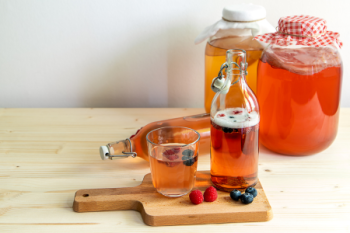
Get to know your basic beverages!
- Beer is made with fermented gains, usually barley or a blend of grains, and flavored with hops.
- A spirit is made when you take a fermented grain mash and distill it.
- A cider is made by fermenting fruit juice—most commonly apple, but it could be other fruits.
- Kombucha is a fermented tea. It is a kind of tea that has gone through microbial fermentation for a long period of time.
- Fermenting honey with water makes mead. Optionally, fruits, spices, grains, and hops can be added to give it different flavors.
- Wine, like cider, is a fermented drink made from fruit—usually grapes, but it can be made with other fruits. Wine has a much longer fermentation process than beer or cider and it is allowed to age for months to years.
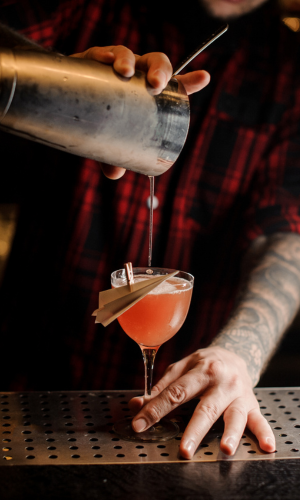
More About Cocktails
The term "cocktail" was first seen in March of 1798 in a British newspaper but was more defined in 1806. In The Balance and Columbian Repository of Hudson, New York, they defined the cocktail as “a stimulating liquor composed of any kind of sugar, water, and bitters, vulgarly called a bittered sling.” Cocktails were partly inspired by British punches, which were made of spirits, fruit juices, and spices in big bowls. Due to Prohibition, World Wars, and an increase in tourism, bartenders were introduced to Polynesian culture, and interest in Tiki drinks increased.
Tiki and cocktail cultures have waxed and waned over the years, but you can find classic cocktails at many bars and can learn to make them on your own.
Prepare Your Potions!
Now that you've done some light background reading, pick your potions to practice for the next Halloween shindig!
Going for a vintage aesthetic? Try some classic cocktails. Embracing the tropical swamp thing? Tiki drinks are for you. Looking to impress with some bespoke brews? Try fermenting your own. And we haven't forgotten the designated drivers, those participating in Sober October, or the younger folks who still want fun, fancy drinks. Try mixing some mocktails or making your own soda syrups, floats, and egg creams.
Class is in session! Get your wicked witch on with books on brewing boozy beverages and other concoctions.
Interested in cooking a full meal? Head over to Cauldron Concoctions: Slow-Cooked Recipes for Fall for low and slow, fix-it and forget-it recipes for the cooler season.
Cocktails

Create your own handcrafted drinks and cocktails using local, fresh, or foraged ingredients. Tired of boring, artificial, too-sweet drinks? Go wild! It's time to embrace drinks featuring local, fresh, or foraged ingredients. It's easy with Wild Drinks & Cocktails.
Using ingredients you can find in your own backyard, farm, or local market, you can create artisan drinks that will leave you feeling refreshed and even revitalized. Learn useful fermentation techniques to make your own water kefir and homemade soda. Brew your own teas, mix your own squashes, shrubs, switchels, tonics, and infusions. You can even use the recipes to create powerful and healthful craft cocktails.
Craft drink expert Emily Han creates unique flavors in the 100 drink recipes, each with powerful health benefits, along with a sentimental nod to drinks of another era. Wild Drinks & Cocktails teaches you the techniques you need to know to handcraft your own infused waters, syrups, vinegar drinks, spirits, wines, and sodas.

Dead Rabbit Grocery & Grog in Lower Manhattan has dominated the bar industry, receiving award after award including World's Best Bar, World’s Best Cocktail Menu, World’s Best Drink Selection, and Best American Cocktail Bar. Now, the critically acclaimed bar has its first cocktail book, The Dead Rabbit Drinks Manual, which, along with its inventive recipes, also details founder Sean Muldoon and bar manager Jack McGarry’s inspiring rags-to-riches story that began in Ireland and has brought them to the top of the cocktail world.
Like the bar’s décor, Dead Rabbit’s award-winning drinks are a nod to the “Gangs of New York” era. They range from fizzes to cobblers to toddies, each with its own historical inspiration. There are also recipes for communal punches as well as an entire chapter on absinthe. Along with the recipes and their photos, this stylish and handsome book includes photographs from the bar itself so readers are able to take a peek into the classic world of Dead Rabbit.

Skip the crowded bar, coffee shop, and restaurant and bring the magic of Disney’s drinks right to your home with over 100 easy, delicious drink recipes inspired by the Disney Parks.
Raise a glass to bringing the magic of Disney straight to your home with The Unofficial Disney Parks Drink Recipe Book. From coffee and tea to milkshakes and slushies to mocktails and cocktails, this book features over 100 of your favorite beverages from the happiest place on Earth.
Recipes are taken straight from your favorite restaurants and cafes throughout the Disney Parks and Resorts.
You’ll learn to make delicious, unique drinks without waiting in line including:
- Coffee and teas, like Frozen Cappuccino from Joffrey’s and Teddy’s Tea from Jock Lindsey’s Hangar Bar
- Fruity drinks and slushies like Frozen Sunshine from Beaches and Cream and the Goofy Glacier from Goofy’s Candy Company
- Mocktails and cocktails like the Sparkling No-Jito from the Tambu Lounge or the La Cava Avocado from Mexico in Epcot
- And dessert drinks like the Peanut Butter and Jelly Milkshake from 50's Prime Time Café or the Dole Whip Float from Aloha Isle
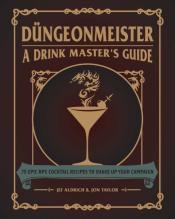
Düngeonmeister: A Drink Master's Guide by Jef Aldrich
Celebrate your campaigns and conquests with these 75 fun, RPG-inspired cocktail recipes your whole gaming group will love!
Make your next gaming adventure even more fun with this collection of 75 RPG-inspired cocktails! Featuring fantasy-themed libations from the boozy Dragon the Beach and a Potion of Strength to a sneaky Stealth Check shot and a Never Split the Party Punch, you’ll keep spirits high and your friends happy during your next dungeon-crawling tabletop adventure.
Complete with easy-to-follow, accessible instructions, Düngeonmeister also includes funny jokes and hilarious asides that will take your campaign (or your next gathering) to the next level!

Have you ever seen a delicious-looking drink on your favorite movie or TV show and wondered how to make it? Well, now you can, with this collection of recipes from the creator of the popular Cocktail Chemistry YouTube channel Nick Fisher.
Featuring recipes to recreate the classic White Russian from The Big Lebowski, the iconic martini from the James Bond movies, to drinks featured in Mad Men, The Simpsons, It’s Always Sunny in Philadelphia, Game of Thrones, The Office, Harry Potter, and more, Cocktail Chemistry will have you impressing your friends with your bartending skills in no time. In addition to recipes, Cocktail Chemistry includes everything you need to know to become a mixology expert, from how to make perfectly clear ice, delicious foams, and infusions, or how to flame a citrus peel. A must-have for all aspiring home mixologists and pop-culture buffs, Cocktail Chemistry will ensure you never have a boring drink again.
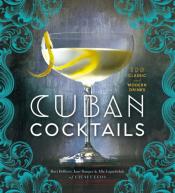
Cuban Cocktails: 100 Classic & Modern Drinks by Ravi DeRossi
From the renowned Cuban rum bar Cienfuegos—owned by the co-owner of Death & Co., named Best American Cocktail Bar at Tales of the Cocktail® in 2010—comes this spirited collection of 100 recipes that celebrate Cuba’s rich history and culture. It features timeless classics, such as the Cuba Libre, El Floridita Daiquirí, and Mojito; a bevy of punch recipes to share with friends and family; new takes on familiar favorites, such as the Isla Tea, Por Avion, and Rum Old Fashioned; and modern craft concoctions, including the Havana Harbor Special, Imperial Fizz, and One Hundred Fires. But Cuban Cocktails offers more than just a collection of delectable recipes. It captures the tropical elegance and unfiltered energy of old Cuba, brimming with beautiful, evocative images of the drinks and the places where they came to life. Features shed fascinating light on the country’s cocktail history, its legendary bars, and the famous cantineros who ran them, while notes, tips, and tricks make it easy to create a tantalizing taste of the once-forbidden Caribbean island. ¡Bienvenidos a Cienfuegos!
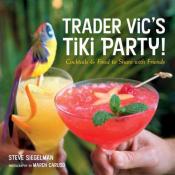
Trader Vic's Tiki Party!: Cocktails and Food to Share with Friends by Stephen Siegelman
The tiki volcano is erupting all over again, and now Trader Vic’s, the legendary purveyor of Polynesian food, drinks, and fantasy, wants to help us bring it all home. Step behind the bar and into the kitchen at Trader Vic’s and learn how to create the kind of tiki magic that made “the Trader” famous. It’s all here: recipes for 95 of the restaurant’s best-loved tropical cocktails and after-dinner drinks along with more than 35 party-friendly recipes for pupus, tidbits, finger food, entrées, and desserts—all adapted from the past and present menus of Trader Vic’s. Dozens of tips and ideas for inexpensive, easy tiki decorating and entertaining at home are included, as is a guide to the basics of bartending equipment and techniques. Whether it’s a blowout tiki party for friends or a spontaneous occasion to dust off the shaker, this book brings favorite concoctions from Trader Vic’s into your home.
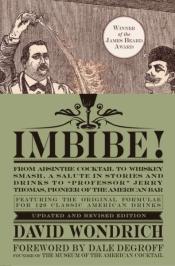
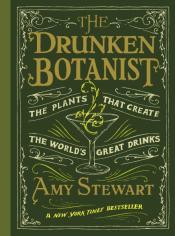
The Drunken Botanist: The Plants That Create the World's Great Drinks by Amy Stewart
Every great drink starts with a plant. Sake began with a grain of rice. Scotch emerged from barley. Gin was born from a conifer shrub when a Dutch physician added oil of juniper to a clear spirit, believing that juniper berries would cure kidney disorders. The Drunken Botanist uncovers the enlightening botanical history and the fascinating science and chemistry of over 150 plants, flowers, trees, and fruits (and even one fungus).
Some of the most extraordinary and obscure plants have been fermented and distilled, and they each represent a unique cultural contribution to our global drinking traditions and our history. Molasses was an essential ingredient in American independence: when the British forced the colonies to buy British (not French) molasses for their New World rum-making, the settlers' outrage kindled the American Revolution. Rye, which turns up in countless spirits, is vulnerable to ergot, which contains a precursor to LSD, and some historians have speculated that the Salem witch trials occurred because girls poisoned by ergot had seizures that made townspeople think they'd been bewitched. Then there's the tale of the 30-year court battle that took place over the trademarking of Angostura bitters, which may or may not actually contain bark from the Angostura tree.
With a delightful two-color vintage-style interior, over fifty drink recipes, growing tips for gardeners, and advice that carries Stewart's trademark wit, this is the perfect gift for gardeners and cocktail aficionados alike.
Mocktails
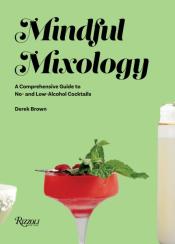
Mindful Mixology: A Comprehensive Guide to No- and Low-Alcohol Cocktails by Derek Brown
From Dry January to Sober October, moderation is having a moment. This book from spirits expert Derek Brown (a newly mindful drinker himself) will show the sober and sober-curious how to mix complex, sophisticated low- and no-proof drinks. It will include recipes, techniques, and sources.
Not long after his son was born, Derek Brown decided to cut back on his drinking. But as a bartender, bar owner, and cocktail and spirits expert, he wanted to do so using the techniques and expertise of mixology to create a new arsenal of libations that were sophisticated, satisfying, and tasty.
Creating these drinks isn’t as simple as removing the alcohol. No- and low-proof cocktails still have to be balanced and still have to be delicious, but they don’t operate exactly like cocktails with alcohol. The drinks Brown presents in this book are meticulously choreographed around taste, texture, body, and piquancy to result in surprisingly complex “adult beverages” minus the booze. Drawing on historical research, meticulous tweaking of classic cocktails to create lower-proof versions, and entirely new concoctions inspired by an evolved home bar, in this book, Derek shares sixty recipes for no- and low-proof cocktails, as well as a guide to the ingredients and equipment you need to imbibe in Mindful Mixology at home.
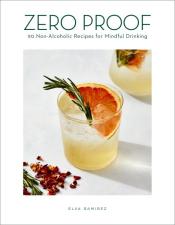
Zero Proof: 90 Non-Alcoholic Recipes for Mindful Drinking by Elva Ramirez
More than 100 years after Prohibition was enacted, bartenders are actually excited about people not drinking again. From Dry January and alcohol-free bars opening around the country to people interested in abstaining from drinking for better health, the no-proof movement is one of today's fastest-growing lifestyle choices, as consumers become more mindful and re-examine their relationship to alcohol. The no-proof drinker could be anyone, and even traditional bars have taken note with no-alcohol offerings. What do the world's most talented bartenders concoct when they can't use booze? This book answers that question with 90 lush and sophisticated recipes that take the craft to new heights. Veteran reporter Elva Ramirez interviewed the biggest names in cocktails and collected recipes for vibrant no-proof drinks from the world's top bars in Paris, London, and New York. This is the start of a new era in no-proof drinking.
Find recipes from renowned bars all over the world, including Death & Co in Denver and NYC, Employees Only, The Aviary NYC, Broken Shaker in LA, Everleaf Drinks in London, Little Red Door in Paris, and many more.
Brews
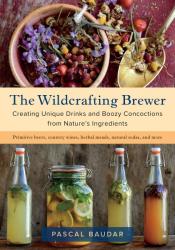
The art of brewing doesn’t stop at the usual ingredients: barley, hops, yeast, and water. In fact, the origins of brewing involve a whole galaxy of wild and cultivated plants, fruits, berries, and other natural materials, which were once used to make a whole spectrum of creative, fermented drinks.
Now fermentation fans and home brewers can rediscover these “primitive” drinks and their unique flavors in The Wildcrafting Brewer. Wild-plant expert and forager Pascal Baudar’s first book, The New Wildcrafted Cuisine, opened up a whole new world of possibilities for readers wishing to explore and capture the flavors of their local terroir. The Wildcrafting Brewer does the same for fermented drinks. Baudar reveals both the underlying philosophy and the practical techniques for making your own delicious concoctions, from simple wild sodas, to non-grape-based “country wines,” to primitive herbal beers, meads, and traditional ethnic ferments like tiswin and kvass.
The book opens with a retrospective of plant-based brewing and ancient beers. The author then goes on to describe both hot and cold brewing methods and provides lots of interesting recipes; mugwort beer, horehound beer, and manzanita cider are just a few of the many drinks represented. Baudar is quick to point out that these recipes serve mainly as a touchstone for readers, who can then use the information and techniques he provides to create their own brews, using their own local ingredients.
The Wildcrafting Brewer will attract herbalists, foragers, natural-foodies, and chefs alike with the author’s playful and relaxed philosophy. Readers will find themselves surprised by how easy making your own natural drinks can be and will be inspired, again, by the abundance of nature all around them.
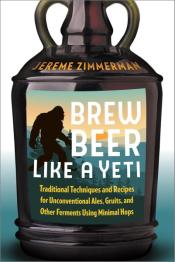
Experimentation, mystery, resourcefulness, and, above all, fun are the hallmarks of brewing beer like a Yeti.
Since the craft beer and homebrewing boom of the late 20th and early 21st centuries, beer lovers have enjoyed drinking and brewing a vast array of beer styles. However, most are brewed to accentuate a single ingredient—hops—and few contain the myriad herbs and spices that were standard in beer and gruit recipes from medieval times back to ancient people's discovery that grain could be malted and fermented into beer.
Brew Beer Like a Yeti returns to ancient practices and ingredients and brings storytelling, mysticism, and folklore back to the brewing process, including a broad range of ales, gruits, bragots, and other styles that have undeservingly taken a backseat to the IPA. Recipes inspired by traditions around the globe include sahti, gotlandsdricka, oak bark and mushroom ale, wassail, pawpaw wheat, chicha de muko, and even Neolithic "stone" beers.
More importantly, under the guidance of "the world's only peace-loving, green-living Appalachian Yeti Viking," readers will learn about the many ways to go beyond the pale ale, utilizing alternatives to standard grains, hops, and commercial yeasts to defy the strictures of style and design their own brews.

Ancient societies brewed flavorful and healing meads, ales, and wines for millennia using only intuition, storytelling, and knowledge passed down through generations―no fancy, expensive equipment or degrees in chemistry needed.
In Make Mead Like a Viking, homesteader, fermentation enthusiast, and self-described “Appalachian Yeti Viking” Jereme Zimmerman summons the bryggjemann of the ancient Norse to demonstrate how homebrewing mead―arguably the world’s oldest fermented alcoholic beverage―can be not only uncomplicated but fun.
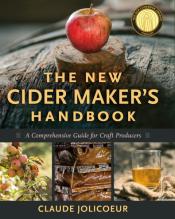
The New Cider Maker's Handbook: A Comprehensive Guide for Craft Producers by Claude Jolicoeur
All around the world, the public’s taste for fermented cider has been growing more rapidly than at any time in the past 150 years. And with the growing interest in locally grown and artisanal foods, many new cideries are springing up all over North America, often started up by passionate amateurs who want to take their cider to the next level as small-scale craft producers. To make the very best cider―whether for yourself, your family, and friends, or for the market―you first need a deep understanding of the processes involved, and the art and science behind them. Fortunately, The New Cider Maker’s Handbook is here to help.
Author Claude Jolicoeur is an internationally known, award-winning cider maker with an inquiring, scientific mind. His book combines the best of traditional knowledge and techniques with up-to-date, scientifically based practices to provide today’s cider makers with all the tools they need to produce high-quality ciders. The New Cider Maker’s Handbook is divided into five parts This book will appeal to both serious amateurs and professional cider makers who want to increase their knowledge, as well as to orchardists who want to grow cider apples for local or regional producers. Novices will appreciate the overview of the cider-making process, and, as they develop skills and confidence, the more in-depth technical information will serve as an invaluable reference that will be consulted again and again. This book is sure to become the definitive modern work on cider making.
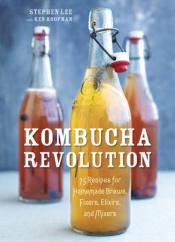
Kombucha Revolution: 75 Recipes for Homemade Brews, Fixers, Elixirs, and Mixers by Stephen Lee
Kombucha—a fizzy, fermented tea-based beverage packed with probiotics, vitamins, and enzymes—has home brewers salivating. And who better to guide you through the brewing process than a tea guru with more than forty years of experience under his belt? Stephen Lee, cofounder of Tazo Tea and Stash Tea, turned his attention to fermented tea and founded Kombucha Wonder Drink in 2001. In Kombucha Revolution, Lee reveals the secrets to brewing the perfect batch of kombucha and caring for your very own SCOBY (Symbiotic Culture of Bacteria and Yeast). He also shares his favorite recipes—plus contributions from brewers, bartenders, and chefs like “Kombucha Mamma” Hannah Crum and Wildwood’s Dustin Clark—for infusing your brew with fruits, herbs, and spices, and incorporating it into juices, smoothies, sauces, snacks, sweets, and cocktails.
With recipes for Lavender–Green Tea Kombucha, Cranberry Bitters Cocktails, Kombucha Vinegar, Green Smoothies, Kombucha Lime Ceviche, and Kombucha Pear Sorbet, mixing this healthful brew into your everyday lifestyle has never been so revolutionary.
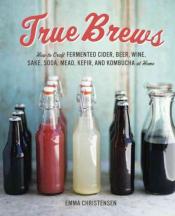
This accessible home-brew guide for alcoholic and non-alcoholic fermented drinks, from Apartment Therapy: The Kitchn's Emma Christensen, offers a wide range of simple yet enticing recipes for Root Beer, Honey Green Tea Kombucha, Pear Cider, Gluten-Free Sorghum Ale, Blueberry-Lavender Mead, Gin Sake, Plum Wine, and more.
You can make naturally fermented sodas, tend batches of kombucha, and brew your own beer in the smallest apartment kitchen with little more equipment than a soup pot, a plastic bucket, and a long-handled spoon. All you need is the know-how.
That’s where Emma Christensen comes in, distilling a wide variety of projects—from mead to kefir to sake—to their simplest forms, making the process fun and accessible for homebrewers. All fifty-plus recipes in True Brews stem from the same basic techniques and core equipment, so it’s easy for you to experiment with your favorite flavors and add-ins once you grasp the fundamentals.
Covering a tantalizing range of recipes, including Coconut Water Kefir, Root Beer, Honey–Green Tea Kombucha, Pear Cider, Gluten-Free Pale Ale, Chai-Spiced Mead, Cloudy Cherry Sake, and Plum Wine, these fresh beverages make impressive homemade offerings for hostess gifts, happy hours, and thirsty friends alike.
Other Concoctions
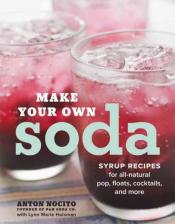
Make Your Own Soda: Syrup Recipes for All-Natural Pop, Floats, Cocktails, and More by Anton Nocito
Sweet-tart lime. Bright cherry. Creamy vanilla.
Natural sodas are vibrantly flavored with the zing of just-squeezed citrus juice, the sweetness of ripe berries, or the subtle perfume of fresh herbs. And with the popularity of countertop appliances that turn tap water into sparkling water, it’s easier than ever to make the real thing on your own, simply mix fresh soda syrup with bubbly water for a drink that’s as sweet (or not) as you like—minus any artificial colors, flavors, or sweeteners.
In Make Your Own Soda, you’ll find 70 recipes for all-natural syrups with unique, artisanal flavors like pineapple, lemongrass, and hibiscus, as well as old-time favorites like ginger, sarsaparilla, and grape. You’ll also find great ways to use homemade syrups to create soda fountain classics (Chocolate Egg Cream), great cocktails (Lovage Gin Fizz), and hot drinks (Hot Apple Spice Cup), all as delicious as they are distinctive.
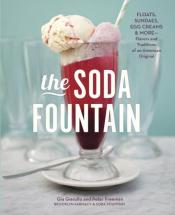
A century ago, soda fountains on almost every Main Street in America served as the heart of the community, where folks shared sundaes, sodas, ice cream floats, and the news of the day. A quintessentially American institution, the soda fountain still speaks of a bygone era of innocence and ease. When Brooklyn Farmacy & Soda Fountain opened its doors in 2010, it launched a revival of this great American original, capturing the hearts of a new generation.
Featuring abundant full-color photography and vintage illustrations and advertisements, The Soda Fountain explores a rich history—from the origins of seltzer in the nineteenth century, through the transformation of soda during Prohibition and the Depression years, right up to today’s fountain renaissance. Featured recipes range from classics like the Purple Cow and Cherry Lime Rickey to contemporary innovations that have made Brooklyn Farmacy famous, like The Sundae of Broken Dreams (topped with caramel sauce and broken pretzel bits) and Makin’ Whoopie! Sundae (with hot fudge and mini chocolate whoopie cakes).
Recreating beloved treats like egg creams and milkshakes with local, seasonal, and artisanal ingredients, Gia Giasullo and Peter Freeman, the sibling cofounders of Brooklyn Farmacy & Soda Fountain, teach you how to resurrect the proud American soda fountain tradition at your own kitchen counter. With its fascinating anecdotes, mouth-watering pictures and easy-to-follow steps,this nostalgic cookbook proves that the soda fountain is a culinary and cultural institution that continues to delight.
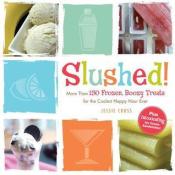
Slushed!: More Than 150 Frozen, Boozy Treats for the Coolest Happy Hour Ever by Jessie Cross
Who says pops are just for kids?
In the sweltering summer heat, you need a quick way to cool down and keep the party going. In this refreshingly spirited volume, you'll find a frosty collection of more than 150 booze-infused frozen desserts, such
With full-color photos and unique party tips, Slushed! guarantees you'll have an intoxicatingly cool summer!
Slushed! comes to you from the kitchen of nationally acclaimed blogger Jessie Cross of The Hungry Mouse (thehungrymouse.com). It also includes good, basic instructions for making ice cream, gelato, frozen yogurt—and has a primer for equipment and ingredients.

The Boozy Baker: 75 Recipes for Spirited Sweets by Lucy Baker
The Boozy Baker is a fun collection of recipes for cakes, pies, tarts, cookies, and more, all of which contain a healthy dose of alcohol. Home bakers will recognize classic treats such as profiteroles, peach cobbler, and spiced Bundt cake, and be delighted by the ways they are reinvented with chocolate stout, almond liqueur, and even Järmeister. Featuring more than 30 full-color photographs, the book also includes sidebars throughout with instructions for preparing funky cocktails that add a punchy compliment to many of the recipes.
Whether you are a pastry perfectionist or a one-bowl beginner, a bonafide mixologist or just looking for a way to polish off a few dusty bottles, this cookbook is sure to become a favorite, its pages splattered with chocolate, sprinkled with sugar, and garnished with a twist.